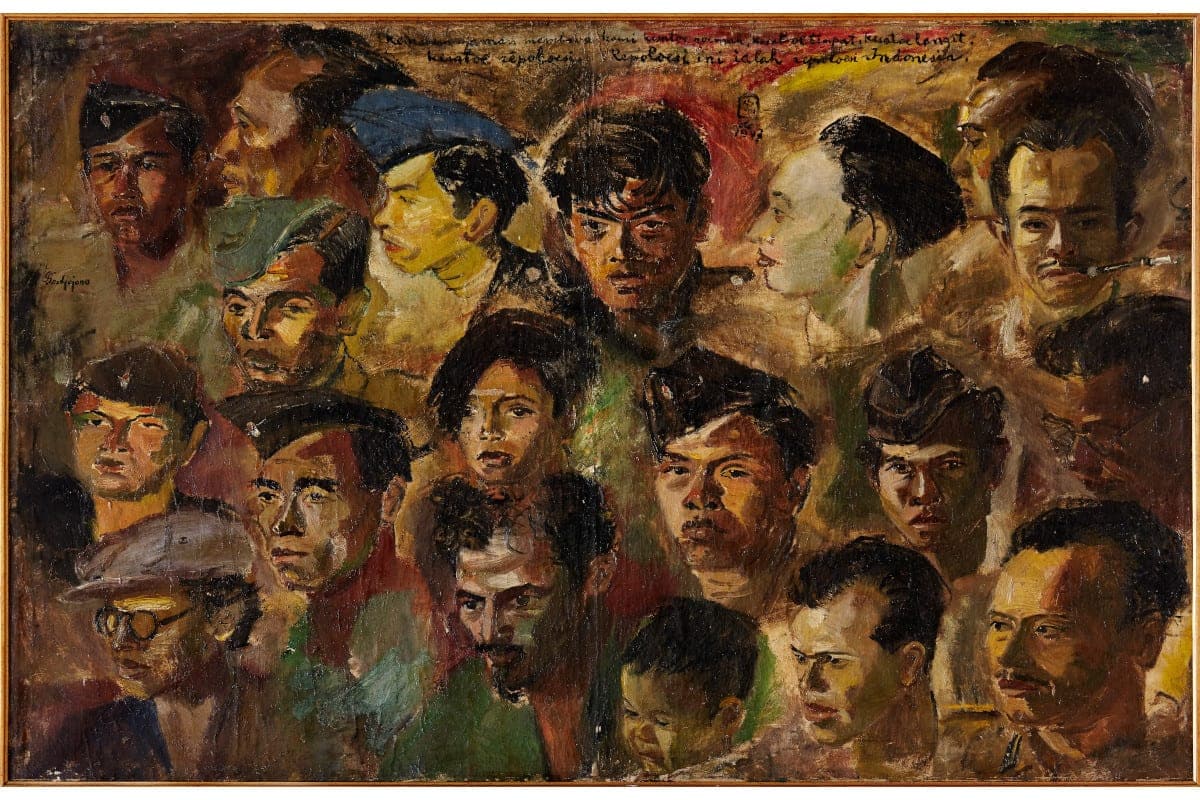by YATUN SASTRAMIDJAJA

Indonesia’s National Revolution (17 August 1945 – 27 December 1949) was made up of a series of complex and chaotic events that it is impossible to capture in a single narrative. Yet, for almost eight decades, the historical record of Indonesia’s struggle for independence has been dominated by two standardised narratives: an Indonesian version and a Dutch version, serving the interests of the respective nation-states. Neither left much room for the myriad of stories reflecting the experiences and actions of people who lived through messy situations on the ground. As these stories faded from official history nonetheless they escaped historical erasure, surviving in art works, in family heirlooms and mundane objects stored in attics, and in personal anecdotes told by grandparents and parents to their children. Those stories constitute the fibres of revolution as living history. Yet they never made the history textbooks or national museum displays.
This changed when Dutch curators of the Rijksmuseum in Amsterdam collaborated with two guest curators from Indonesia, historian Bonnie Triyana and art historian Amir Sidharta, to create a groundbreaking exhibition at the Netherlands’ most important national museum. The exhibition, which ran from 11 February to 6 June 2022, was titled Revolusi! Indonesië Onafhankelijk (Revolution! Indonesia Independent). The mixed use of Indonesian and Dutch languages in the title, and the collaboration between Indonesian and Dutch curators, indicates that the exhibition sought to bring together the hitherto separated stories of Indonesian and Dutch experiences of the revolution. The aim was to offer new perspectives on the Revolution by foregrounding the personal stories of people in different positions. As the blurb for the accompanying book states, ‘Revolusi! presents a range of personal and collective experiences, told from multiple points of view: from Indonesian and Dutch perspectives as well as those of the groups and individuals in between, with an eye towards the international power arena.’
However, from the start to its closing, controversy surrounded the exhibition. First, an opinion piece by Bonnie Triyana, published on 10 January 2022 in the Dutch newspaper NRC Handelsblad, caused a public stir as he argued for removal of the ‘racist’ term Bersiap from the exhibition. Bersiap was the name given by the Dutch to a period of violence (August 1945 – December 1946) during Indonesia’s Revolution. Until this day, it is typically the only period and aspect of the Revolution highlighted in Dutch history textbooks. Dutch right-wing politicians fiercely denounced Triyana’s ‘Bersiap denial’ and the Federation of Indo-Dutch (Federatie Indische Nederlanders) reported Triyana to the police. While the Dutch public prosecutors did not pursue the charges, the Rijksmuseum quickly distanced itself from the controversy, stating that Triyana had expressed his personal opinion in the article.
The controversy was a stark reminder of the persistent sensitivities around this shared but separated history of colonialism and decolonisation. Bridging Dutch and Indonesian perspectives on Indonesia’s Revolution proved to be a complex and painful affair, and one bridge too far for the Rijksmuseum once it met with reproach from a small group of citizens and politicians. Moreover, the Rijksmuseum came unprepared for the criticism and protest coming from minority and marginalised groups among the Indonesian diaspora in the Netherlands. This included people of Papuan descent and others who felt the exhibition failed to acknowledge their histories and the impact of Revolusi on contemporary lives and social and political conditions, both in Indonesia and the Netherlands.
In the end, the exhibition did not stray that far from the established grand narratives of the Revolution, either the Dutch or the Indonesian versions. While breaking new ground by accentuating personal stories from multiple perspectives, it did not fundamentally challenge the nationalist framework for understanding history on either side. As culture historian Caroline Drieënhuizen wrote, this is partly due to the minimal historical context it provided to the objects and stories on display, which resulted in ‘a rather uniform representation of the position of the Indonesian population in the war.’
Given its objective of multivocality, the exhibition was one first institutional step towards unlocking a diversity of historical experiences around the Revolution in a museal setting. Yet, as the museum’s wavering response to the uproar around Triyana’s article indicates, the bastions of historical representation still have a long way to go in recognising the decolonial implications of this objective; this includes a responsibility to confront the power relations enshrined and perpetuated in grand narratives. Still, a diversity of experiences were visible in the closing section of the exhibition in a series of film portraits called Afterlives of Revolution, created by the independent art and research collective Beyond Walls. Featuring the personal stories of ‘descendants of the Revolution’ from various groups in Indonesia and the Netherlands, these portraits invite us to rethink the meaning of contested history by illustrating the multiple legacies of the Revolution in the present, where the personal and political meanings of this messy history intersect.
Inside Indonesia for more
